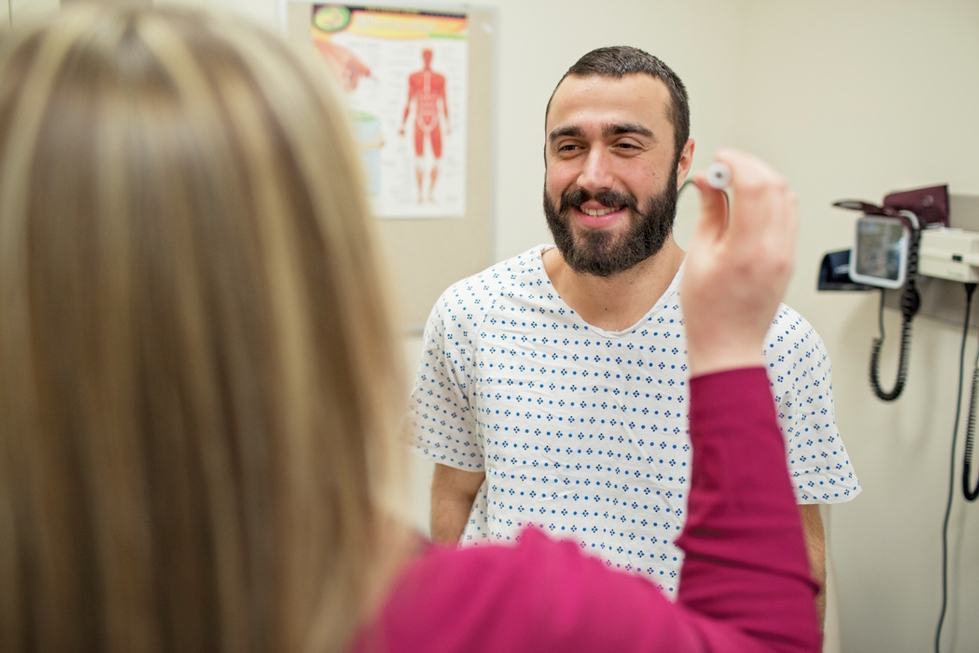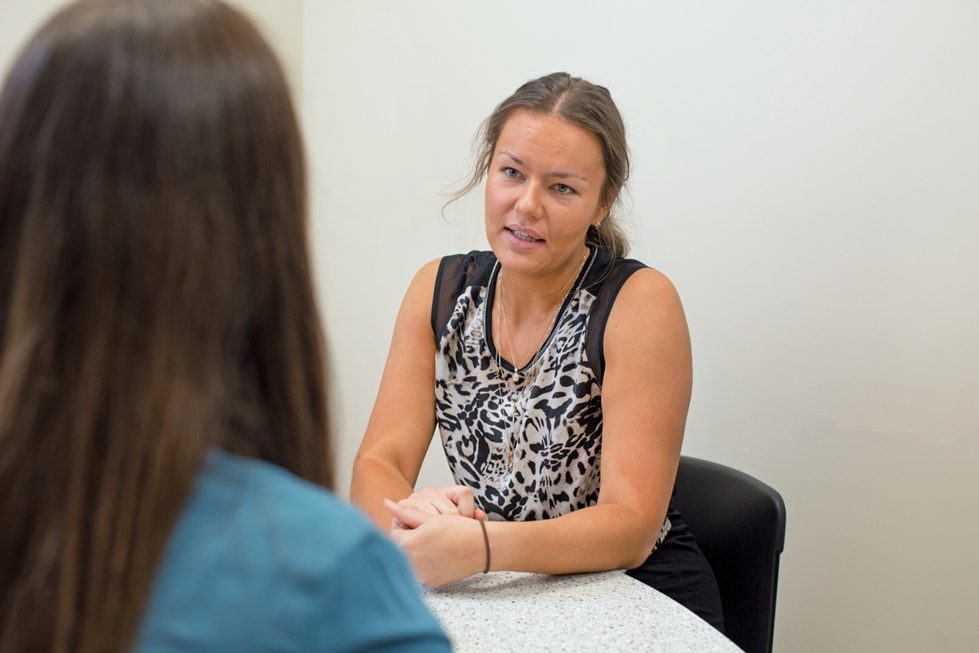Cultural competency in health care
International students train as patients
by Michele Coffill
photos by Jess Weal
He ran through his lines like a professional actor and understood the role well.
Jason Hanna, an international student from Lebanon, was set to portray “Greg,” a man seeking medical treatment after suffering an allergic reaction while mowing his lawn.
“I kept saying to myself, ‘I’m Greg, not Jason,’” Hanna said.
He dressed for the part, wearing a hospital gown over his shorts, and sat on the examination table. The door opened and an upper-level nursing student walked in, offering her hand and introducing herself.
“And I said, ‘Hi, I’m Jason,’” Hanna said.
Despite the minor flub, the rest of the exercise went smoothly, Hanna said. He is one of 15 international students who work as standardized patients (SPs) in the simulation center at the Cook-DeVos Center for Health Sciences. SPs are people trained to portray a patient in a simulated health care setting.
Through the SP program, Grand Valley students who are majoring in nursing, social work or health professions have opportunities to practice and develop skills in a clinical setting.

Jason Hanna undergoes an assessment by a nursing major during a standardized patient scenario.
Program director Cindy Bartman said bringing international students into her pool of about 200 SPs elevates the learning experience for students.
“This is a really unique part of our program and goes along with our commitment to diversity,” Bartman said. “The richness of diversity international students bring is tremendous, adding cultural competency to the many skills taught in the simulation center.”
The partnership between the SP program and the Padnos International Center began last year. Libby Jawish, international student integration coordinator, said the program goes beyond helping international students find a job.
“We have a few nursing and health professions majors, but not many,” Jawish said. “Through their work with Cindy, they get to experience a different part of campus.”
International students are restricted by their visas to securing only campus jobs. Students who are SPs can work as much or as little as their schedule allows. Typically, SPs will portray the same patient for three or four different rotations of students during a three-hour block.
Bartman and others fill about 600 SP opportunities each semester. For a SP, the simulations range in degree of complexity. One day could mean wearing street clothes and meeting social work students for interviews.
Other days, like the annual mock burn unit, require more preparation. Staff members apply moulage and bandages to SPs to make them appear as burn victims who are ready to be examined by students majoring in occupational therapy, physical therapy or physician assistant studies.
“In the field of social work, we are always working with diverse populations. Working with a SP from another country provides another layer of cultural awareness and exposure.”
— Paul Kiger, adjunct faculty in social work
Hanna also works as a resident assistant. He is in his third and final year at Grand Valley, although he intended to stay for only one. Opportunities like the SP program played a role in extending his stay to earn a degree from Grand Valley.
“I wouldn’t have opportunities like this back home,” he said. A biomedical sciences major, Hanna hopes to someday be a physician and said working as a SP allows him to understand the health care system from a patient’s perspective.
“Learning how to communicate with patients is crucial for a physician and this really opened my eyes to what it’s like to be a patient,” he said. Hanna graduated in April and has applied to medical schools in Lebanon.

Kateryna Radko plays the role of a woman arrested for drunken driving and ordered to attend counseling; she is pictured talking with a social work student.
Kateryna Radko, an international relations major, is from Ukraine and in her second semester as an SP. During one simulation in January, she took on a SP role of a women who was arrested for drunken driving and ordered to undergo counseling.
She has always enjoyed acting and said this is a good opportunity to help other students. “I enjoy meeting new people and I’m always impressed with these students; this is a challenging thing to do,” Radko said.
Mackenzie Vandermei was one of the social work students who worked with Radko. It was Vandermei’s first simulation. She knew only Radko’s name before meeting her, a situation that she said mirrors the profession as a case worker may have few details before meeting a client.
Through a 15-minute casual, yet sometimes pointed, conversation, Vandermei was able to draw out details of Radko’s “arrest.” “I was a little nervous when I first heard her accent, but it went really well,” Vandermei said.
Radko said portraying roles during social work simulations can be taxing.
“Every case is different and in social work you can be a little bit of yourself,” she said. “Some cases are very emotional, like portraying a domestic violence victim. I cried every time I was in that role. “When I got home, I said to myself, ‘You need to get yourself out of this role.’”
Through her SP work, Radko’s verbal and written communication skills have improved, she said. At the end of each simulation, SPs provide each student with written or verbal feedback. “I try to be constructive with my critiques. It’s important,” Radko said.
Paul Kiger, adjunct faculty in social work, supervised Vandermei and others in her class during the simulation.
Through a live video monitoring system, he sat in a main room in the simulation center and evaluated students who conducted interviews in four different rooms.
He said simulations are important to help prepare students for the workforce, as it’s not an interview with a classmate or someone else they know. “They are engaging in a meeting that feels authentic and organic,” Kiger said.
Working with an international student SP elevates the learning experience, he said. “In the field of social work, we are always working with diverse populations. Working with a SP from another country provides another layer of cultural awareness and exposure,” Kiger said.
